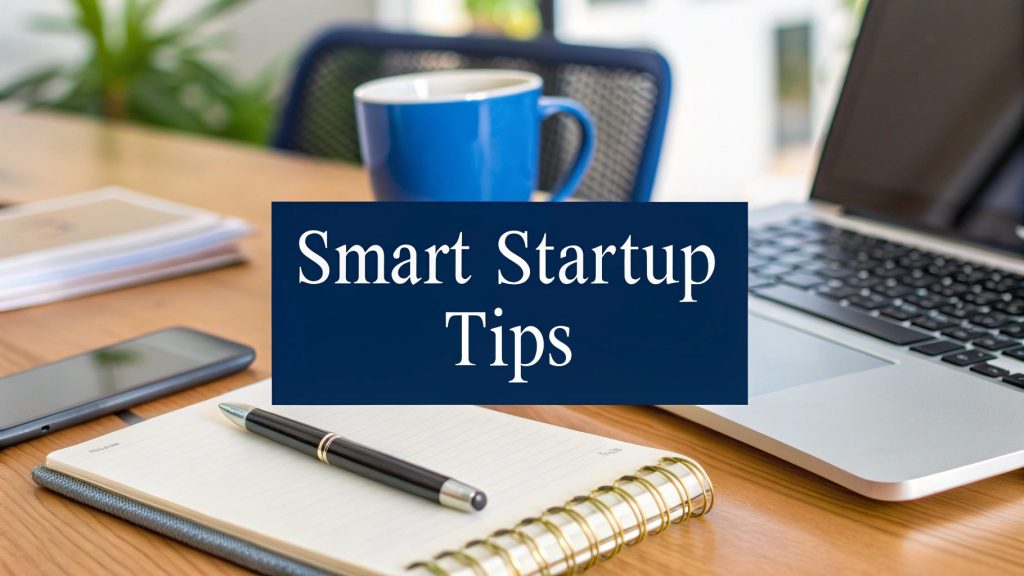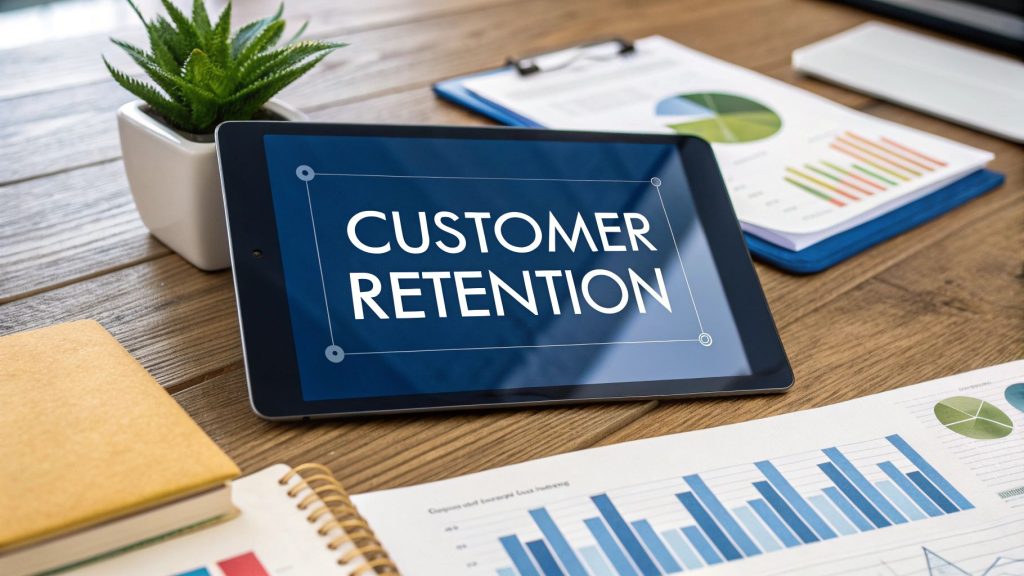10 Actionable Marketing Tips for Small Businesses
Marketing Tips for Small Businesses – Navigating the marketing landscape can feel overwhelming for a small business owner. With limited budgets and time, every decision counts, making it essential to focus on high-impact strategies. This guide cuts through the noise, offering a definitive list of practical and affordable marketing tips for small businesses, specifically designed to deliver tangible results. We are moving beyond generic advice to provide actionable tactics you can implement immediately.
This is not a theoretical overview; it’s a hands-on playbook. You will learn how to build a loyal community through targeted social media, drive repeat business with effective email campaigns, and dominate local search results to attract nearby customers. We will also explore how to forge strategic partnerships and harness the power of video content, even with minimal resources. Each point is structured to help you connect meaningfully with your audience, drive sustainable growth, and build a resilient brand. These are the strategies that will make a significant impact on your bottom line, equipping your business for success in 2025 and beyond. Let’s dive in.
1. Leverage Social Media Marketing
Social media marketing involves using platforms like Instagram, Facebook, LinkedIn, and TikTok to connect with your target audience, build brand awareness, and ultimately drive sales. It’s a powerful and often low-cost method for small businesses to engage directly with potential customers, transforming passive viewers into an active, loyal community. This direct line of communication allows you to gather immediate feedback and build authentic relationships.

This strategy is one of the most vital marketing tips for small businesses because it levels the playing field, enabling you to compete with larger brands without a massive advertising budget. For a practical example, consider a local bakery that posts a daily “behind-the-scenes” Instagram Story showing fresh croissants coming out of the oven. This simple, authentic content drives foot traffic and builds a loyal following more effectively than a generic ad.
How to Implement This Strategy
To get started, first identify which platforms your ideal customers frequent. A B2B tech startup will find more value on LinkedIn, whereas a fashion brand would focus on visually driven platforms like Instagram and TikTok.
- Create a Content Calendar: Plan your posts in advance to ensure a consistent presence. For instance, a fitness coach could plan for “Motivation Monday” posts, “Workout Wednesday” tutorials, and “Client Spotlight Friday” features.
- Engage Authentically: Respond to comments and messages promptly. Don’t just broadcast; interact with your followers’ content to build a genuine community. If a customer tags your coffee shop in their post, reshare it to your Story with a “thank you” message.
- Utilise Platform-Specific Formats: Create Instagram Reels, LinkedIn articles, or TikTok videos that feel native to each platform’s style and audience expectations. A local estate agent could create a 30-second TikTok tour of a new property listing.
- Track Your Performance: Use built-in analytics to see what works. Pay attention to engagement rates, reach, and clicks to refine your content strategy over time. For example, you might discover that your short video posts get twice the engagement of static images.
2. Implement Email Marketing Campaigns
Email marketing involves building a subscriber list and sending targeted messages directly to your audience’s inbox. It is a highly effective way to nurture leads, maintain customer relationships, and drive repeat business by delivering personalised content, promotions, and updates. This direct channel of communication allows you to build loyalty and keep your brand top-of-mind.
This strategy consistently ranks as one of the most powerful marketing tips for small businesses due to its exceptionally high return on investment (ROI). Unlike social media, you own your email list, giving you a reliable way to reach your audience without being at the mercy of algorithm changes. For instance, a small e-commerce store can set up an automated “abandoned cart” email offering a 10% discount to shoppers who left items behind, recovering potentially lost sales.
How to Implement This Strategy
Start by choosing an email marketing platform and creating a simple sign-up form on your website. Offer an incentive, like a discount or a free guide, to encourage subscriptions.
- Segment Your Audience: Group subscribers based on their behaviour or demographics to send more relevant, personalised content. A pet store could create separate email lists for dog owners and cat owners, sending each group tailored product recommendations.
- Craft Compelling Subject Lines: Keep them concise (around 40-50 characters) and intriguing to maximise open rates. Instead of “Monthly Newsletter,” try “5 Dog Training Myths, Busted.” A/B test different options to see what resonates.
- Provide Value, Not Just Sales Pitches: Ensure your emails offer useful information, tips, or entertainment. A garden centre could send a monthly email with tips on what to plant that season, with a small promotion at the end.
- Include a Clear Call-to-Action (CTA): Every email should have a specific goal, guided by a clear button or link, such as “Shop Now,” “Read More,” or “Book a Consultation.”
3. Content Marketing and Brand Strategy
Content marketing is the process of creating and distributing valuable, relevant, and consistent content to attract and retain a clearly defined audience. This is paired with a strong brand strategy, which defines your company’s mission, messaging, and visual identity to build trust and differentiate you from competitors. Together, they create a powerful engine for customer loyalty.

This dual approach is one of the most effective marketing tips for small businesses because it shifts the focus from direct selling to building authority and solving problems. For example, a local accounting firm could write a blog post titled “A Step-by-Step Guide to Self-Assessment for Freelancers in the UK.” This helpful content attracts their ideal clients and establishes them as an expert.
How to Implement This Strategy
Start by defining your brand’s core values and unique voice. Then, identify the key questions and pain points your target audience has, which will form the foundation of your content.
- Define Your Brand Identity: Create a simple brand guidelines document outlining your mission, brand story, logo usage, colour palette, and tone of voice. This ensures consistency across all your marketing.
- Create a Content Plan: Identify keywords your audience searches for and plan content around those topics. A sustainable clothing brand might plan blog posts on “How to Build a Capsule Wardrobe” or “The Benefits of Organic Cotton.”
- Address Customer Pain Points: Develop content that directly helps your audience. A software company could create a guide to improving productivity, positioning their tool as part of the solution.
- Optimise and Repurpose: Ensure every blog post is optimised for search engines. Repurpose a long-form article into a short video for TikTok, a checklist for an email newsletter, and an infographic for Pinterest.
4. Develop a Local SEO Strategy
Local SEO (Search Engine Optimisation) is the practice of optimising your online presence to attract more business from relevant local searches. For a brick-and-mortar or service-area business, this means showing up prominently when a potential customer searches for “plumber near me” or “best cafe in Manchester”. It’s about being visible on Google Maps and in the local search results pack, connecting you directly with customers actively seeking your services in your geographic area.
This strategy is one of the most powerful marketing tips for small businesses because it targets customers with high purchase intent. Consider a local bookshop. When someone searches “independent bookshop in Brighton,” effective local SEO ensures that shop appears in the top results with its address, opening hours, and glowing reviews, driving immediate foot traffic.
How to Implement This Strategy
Getting started with local SEO begins with claiming your digital territory. The primary goal is to signal to search engines that you are a legitimate, trusted business serving a specific community.
- Optimise Your Google Business Profile: Claim and fully complete your free profile. Add high-quality photos, services, opening hours, and ensure your business category is correct. A restaurant should upload photos of its food, menu, and interior.
- Ensure NAP Consistency: Your Name, Address, and Phone number (NAP) must be identical across all online directories like Yelp, Thomson Local, and industry-specific sites.
- Encourage and Respond to Reviews: Actively ask satisfied customers to leave reviews on Google. For example, include a link on your receipts or in a follow-up email. Respond professionally to all feedback, both positive and negative, to show you are engaged.
- Build Local Citations: Get your business listed in reputable local and national online directories. This builds credibility and reinforces your location to search engines.
- Create Location-Specific Content: Write blog posts or create landing pages about local events, news, or services specific to a neighbourhood or city you serve (e.g., a Bristol-based florist could write a blog on “Best Wedding Venues in Bristol”).
5. Utilize Strategic Partnerships and Collaborations
Strategic partnerships involve collaborating with other non-competing businesses to tap into each other’s customer bases, share resources, and amplify marketing efforts. This powerful method allows you to reach a highly relevant audience through a trusted source, effectively gaining a warm introduction instead of a cold one. It’s a mutually beneficial arrangement that drives growth without a significant financial outlay.
This approach is one of the most cost-effective marketing tips for small businesses because it creates a win-win scenario, leveraging shared audiences for exponential reach. For a practical example, a local yoga studio could partner with a nearby healthy juice bar to offer a “Detox Weekend” package, promoting it to both of their customer lists and splitting the profits.
How to Implement This Strategy
The key to a successful partnership is finding a business whose audience aligns with yours but whose products or services are complementary, not competitive. This ensures both parties add genuine value to their customers.
- Identify Potential Partners: Look for businesses that share your values and target demographic. A wedding photographer could partner with a local florist, a venue, and a cake maker.
- Establish Clear Agreements: Before launching anything, create a formal agreement that outlines roles, responsibilities, promotional activities, and how success will be measured.
- Create a Joint Offer: Develop a compelling co-branded offer, such as a bundled service, a joint event, or a cross-promotional discount that benefits both customer bases. A personal trainer and a nutritionist could co-host a “New Year, New You” workshop.
- Promote Collaboratively: Market the partnership across both businesses’ channels, including email lists, social media, and websites, to maximise exposure and impact. For more guidance, you can learn more about how to find business partners on growmyacorn.co.uk.
6. Implement Referral and Word-of-Mouth Marketing
Referral marketing transforms your happiest customers into a powerful, voluntary sales force. It involves incentivising existing clients to recommend your business to their network, leveraging trust and personal relationships to attract new, high-quality leads. This approach capitalises on the simple fact that people trust recommendations from friends and family far more than traditional advertising.
This is one of the most effective marketing tips for small businesses because referred customers often have a higher lifetime value and lower acquisition cost. Think of Dropbox, which achieved explosive growth by offering extra storage space for referrals. A more local example would be a hairdresser offering 20% off the next appointment for both the existing client and the new friend they refer.
How to Implement This Strategy
A successful referral programme should be simple, rewarding, and easy to share. The goal is to make recommending your business a frictionless and mutually beneficial experience for your existing customers.
- Offer Dual-Sided Incentives: Reward both the referrer and the new customer. A “give £10, get £10” model motivates both parties to participate.
- Make Sharing Effortless: Provide customers with a unique, shareable link or code they can easily send via email, text, or social media. For a local service, simple business cards with a “Referred by” line can work wonders.
- Promote Your Programme: Don’t just create a referral programme; actively promote it. A subscription box service could include a flyer in every delivery explaining the referral bonus.
- Track and Acknowledge Referrals: Use simple software or a spreadsheet to track where new customers come from. Always thank your advocates for their support to encourage repeat behaviour. To delve deeper, discover more customer retention strategies.
7. Master Video Marketing
Video marketing involves using video content on platforms like YouTube, Instagram Reels, and TikTok to demonstrate products, tell brand stories, and boost audience engagement. It is an incredibly dynamic and effective way for small businesses to capture attention, explain their value proposition quickly, and create a more personal connection with viewers, leading to higher conversion rates.

This strategy is one of the most powerful marketing tips for small businesses as it humanises your brand and simplifies complex information. A practical example is a local electrician creating a short video titled “3 Signs You Need to Update Your Fuse Box.” This positions them as a helpful expert, building trust before a customer even needs to call.
How to Implement This Strategy
Start by focusing on content that provides value to your audience, such as how-to guides, behind-the-scenes glimpses, or customer testimonials. You don’t need a Hollywood budget; a modern smartphone and good lighting are often enough to begin.
- Hook Viewers Immediately: Capture attention within the first three seconds. A video about baking could start with a close-up shot of melted chocolate being poured, rather than a slow intro.
- Keep It Concise: Aim for videos under two minutes for social media platforms like Instagram and TikTok. For more in-depth topics on YouTube, 5-10 minutes is a good target.
- Include a Clear Call-to-Action (CTA): Tell your viewers exactly what you want them to do next. For example, end a tutorial video with: “If you found this helpful, follow us for more tips!”
- Optimise for Search: Use relevant keywords in your video titles, descriptions, and tags on platforms like YouTube. A video about fixing a leaky tap should have “how to fix a leaky tap” in the title. Add subtitles, as many viewers watch with the sound off.
8. Optimize for Search Engine Marketing (SEM) with PPC Ads
Search Engine Marketing (SEM) involves using paid advertising, primarily through platforms like Google Ads, to place your website at the top of search engine results pages (SERPs). Unlike SEO, which focuses on organic growth, SEM delivers immediate visibility by allowing you to bid on specific keywords your target customers are searching for, driving high-intent traffic directly to your offers.
This strategy is one of the most effective marketing tips for small businesses because it offers precise budget control and quick results. For example, a local plumber can run a Google Ad campaign targeting the keyword “emergency plumber in Bristol.” Their ad will appear at the very top of the results when a homeowner in Bristol has a burst pipe, generating an immediate, high-value lead. This immediate impact makes it one of the best ways to advertise your business.
How to Implement This Strategy
To begin, set a clear monthly budget (a minimum of £300-£500 is a good starting point) and focus on a small, highly targeted set of keywords. Your goal is to attract qualified leads, not just any clicks.
- Target Long-Tail Keywords: Instead of bidding on a broad, expensive term like “shoes,” target a specific phrase like “women’s waterproof walking boots size 6.” This reduces cost and attracts more qualified buyers.
- Write Compelling Ad Copy: Your ad headline and description must align perfectly with the user’s search query and offer a clear benefit. For the emergency plumber, a headline like “24/7 Bristol Plumber – Call Now” is direct and effective.
- Create a Relevant Landing Page: Ensure the page users land on after clicking your ad is a direct continuation of your ad’s promise. The landing page should prominently feature the phone number and an emergency contact form.
- Use Negative Keywords: Actively add terms you don’t want to rank for. A plumber might add “-training” and “-courses” as negative keywords to avoid paying for clicks from people looking for jobs or education, not services.
- Track Everything: Implement conversion tracking from day one to measure which keywords and ads are generating actual sales or leads, allowing you to optimise your spend effectively.
9. Develop a Mobile-First Marketing Strategy
A mobile-first strategy means designing your entire digital presence, from your website to your emails and ads, for the mobile experience before considering the desktop version. With the vast majority of consumers now browsing, shopping, and interacting with brands via their smartphones, this approach ensures you provide a seamless and user-friendly experience where it matters most. It prioritises speed, simplicity, and accessibility for on-the-go users.
This is one of the most critical marketing tips for small businesses because Google prioritises mobile-friendly sites in search rankings (mobile-first indexing). Think of a local restaurant. A mobile-first site would have a large “Reserve a Table” button that is immediately visible and a menu that is easy to read without zooming, ensuring a hungry customer can book in seconds.
How to Implement This Strategy
Start by evaluating your current website on your own smartphone. Is it easy to navigate? Does it load quickly? The goal is to remove all friction between a visitor’s arrival and their desired action.
- Prioritise Performance: Ensure your website loads in under three seconds on a mobile connection. Compress images and streamline code to achieve this.
- Design for Thumbs: Simplify navigation with large, easily tappable buttons (at least 48×48 pixels) and intuitive menus designed for small screens. Place your phone number at the top as a “click-to-call” link.
- Embrace Vertical Formats: Create social media content, especially videos and images, in a vertical 9:16 aspect ratio that naturally fits a phone screen for platforms like Instagram Stories and TikTok.
- Streamline Forms and Checkouts: Reduce the number of fields in contact forms and enable one-click payment options like Apple Pay or Google Pay to boost conversions.
- Test on Real Devices: Don’t just rely on desktop simulators. Test your site and marketing campaigns on various popular smartphones to identify real-world user issues.
10. Use Data Analytics and Customer Insights
Data analytics involves collecting, analysing, and acting on customer data to make smarter marketing decisions. For a small business, this means moving beyond guesswork and using real evidence to understand what your customers want, how they behave, and where to invest your budget. It transforms marketing from a cost centre into a predictable growth engine.
This is one of the most powerful marketing tips for small businesses because it allows you to personalise experiences and optimise spending with precision. For example, by using Google Analytics, an online gift shop might discover that its blog post “Unique Birthday Gifts for Dads” is driving the most traffic. They can then create a paid ad campaign that directs users to that specific post to maximise conversions.
How to Implement This Strategy
Start by using free, powerful tools like Google Analytics 4 to track website traffic and user behaviour. The goal is to turn raw numbers into actionable insights that directly inform your strategy and improve your return on investment.
- Define Key Performance Indicators (KPIs): Set clear goals, such as increasing website conversions or lowering customer acquisition cost, and track the metrics that matter most.
- Track Your Funnel: Monitor how users move from awareness to purchase. You might find many users add items to their cart but don’t check out, indicating a problem with your shipping costs or payment process.
- Use UTM Parameters: Add unique tracking codes to your campaign links. For example, add
?utm_source=facebook&utm_campaign=summer_saleto your ad links to see exactly how many sales came from that specific Facebook campaign. - Gather Qualitative Feedback: Don’t rely solely on numbers. Use customer surveys and feedback forms to understand the “why” behind their actions and improve their experience.
10 Small Business Marketing Strategies — Comparison
| Channel | Implementation | Resources | Effectiveness | Expected outcomes | Ideal use cases |
|---|---|---|---|---|---|
| Social Media Advertising | Medium — campaign setup + continuous optimisation | Ad spend (flexible), creative, analytics tools | High — effective for targeted reach | Rapid traffic, conversions, brand awareness | Product launches, promotions, retargeting |
| Content Marketing | High — strategy, creation, SEO consistency | Time, writing/video skills, SEO tools | High — strong long-term authority | Gradual organic traffic & qualified leads | Thought leadership, lifecycle nurturing |
| SEM / Google Ads | Medium–high — keyword & bid management | PPC budget, landing pages, expert management | High — high-intent conversions | Immediate search visibility & conversions | Demand capture, high-intent sales |
| Email Marketing | Medium — list building + automation setup | ESP tools, content, segmentation data | Very high — excellent ROI and retention | High repeat purchases and engagement | Retention, promotions, cart recovery |
| Influencer Marketing | Medium — partner selection & management | Influencer fees, creative briefs, tracking | Medium — high engagement if authentic | Audience trust, UGC, targeted reach | Niche product launches, social proof |
| Video Marketing | High — production + platform optimisation | Production equipment/software, time | High — very high engagement & conversions | Strong brand recall and conversion lift | Demos, storytelling, social distribution |
| Referral & Affiliate Marketing | Medium — programme setup and partner ops | Incentives, tracking platform, partner outreach | Medium — cost-efficient acquisition | Scalable referrals and high-quality customers | SaaS freemium, e-commerce growth |
| Pay-Per-Click Display Advertising | Medium — creative + programmatic setup | Display budget, creative assets, DSPs | Low–medium — better for awareness/retargeting | Wide reach, low CTR but good remarketing | Brand awareness, retargeting warm users |
| Local SEO & Business Listings | Medium — optimisation + citation management | Time, local listings tools, review processes | Medium — strong local intent results | Improved local visibility & footfall | Brick-and-mortar, service-area businesses |
| Public Relations & Press Releases | High — relationships + story development | PR expertise or agency, media lists | Low–medium — credibility boost if picked up | Earned media, backlinks, brand trust | Product/tech launches, corporate milestones |
| Podcast Advertising | Low–medium — ad placement & tracking | Sponsorship budget, creative script, tracking | Medium — high engagement in niche audiences | Strong listener trust and conversion potential | Niche targeting, brand awareness, long-form ads |
| Event Marketing & Sponsorships | High — planning, logistics, follow-up | Significant budget, staff, materials | Medium — powerful for relationships & leads | Qualified leads, partnerships, brand authority | B2B lead gen, product demos, networking |
Putting Your Marketing Plan into Action
Navigating the world of digital marketing can feel like a monumental task for any entrepreneur or sole trader. However, as we’ve explored, you don’t need a colossal budget or an extensive team to make a significant impact. The power lies in strategic, consistent, and focused execution. The marketing tips for small businesses detailed in this guide are not just theoretical concepts; they are practical, actionable blueprints for growth.
The journey from a startup to a recognised brand is built on a series of well-executed steps. From optimising your local SEO to be the top choice for customers in your community, to building a loyal following through authentic email marketing, each tactic serves as a vital building block. Remember the power of collaboration; a strategic partnership with a complementary local business can introduce your brand to an entirely new, yet relevant, audience.
From Theory to Tangible Growth
The most crucial takeaway is to avoid overwhelm by focusing your efforts. Instead of attempting to master all ten strategies simultaneously, select one or two that most closely align with your immediate business goals and your target audience’s behaviour.
- Is your product or service highly visual? Start by dedicating your resources to mastering video marketing on platforms like Instagram Reels or TikTok. For example, a handmade jewellery maker could create short videos showing their crafting process, which is far more engaging than a static product photo.
- Do you operate a service-based business reliant on local customers? Prioritise your local SEO and referral marketing programmes. A local dog walker, for example, would benefit most from getting great Google reviews and offering a free walk to clients who refer a new customer.
- Need to generate leads quickly? A targeted PPC campaign through Google Ads, combined with a mobile-optimised landing page, could provide the immediate traffic you need while you build your long-term organic presence. A driving instructor could run ads for “driving lessons in [Your Town]” to attract learners ready to book.
The Power of Consistent Action
The secret to successful marketing isn’t a single, brilliant campaign but the cumulative effect of persistent, measured action. The difference between a business that stagnates and one that flourishes often comes down to this simple principle. Commit to your chosen strategy, use data analytics to understand what’s working, and don’t be afraid to refine your approach. Each piece of content you create, every email you send, and every customer insight you analyse is a step towards building a resilient and profitable business. These marketing tips for small businesses are your toolkit; now it’s time to start building.
Ready to turn these marketing tips into a cohesive, powerful strategy for your business? At Grow My Acorn, we specialise in providing practical guides, in-depth resources, and actionable advice tailored specifically for UK small businesses and entrepreneurs. Visit Grow My Acorn to explore the tools and knowledge you need to transform your small steps into significant, sustainable growth.











































